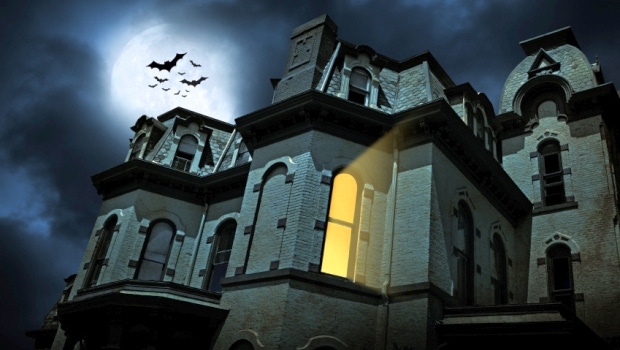Haunted-house operators have ghastly amounts of stuff to store, but as it turns out, some of their storage practices are downright scary. Guest blogger Allie Johnson explores why these companies may make good self-storage tenants and offers tips on how to lure them to your facility.
October 22, 2015

By Allie Johnson
Haunted-house operators have ghastly amounts of stuff to store, but as it turns out, some of their storage practices are downright scary, putting their expensive props and equipment at risk of damage. It would seem they’d be an ideal target audience for self-storage.
Once Halloween is over, it’s common for haunted-house owners to rent or buy used semi-truck trailers or shipping containers to hold their stuff, says Stan Jung, a St.Louis-based conceptual engineer, who has designed haunts all over the world.
However, there are some big problems with that strategy, warns Jung. Because there’s no temperature control in the trailers or containers, expensive latex masks and other props break down quickly. “They become almost like goo,” he says.
Haunt owners often buy used trailers or containers to save money, but those trailers can have holes and gaps that allow insects and rodents to get in and eat away at props. “They go to get their stuff out, and they’ve got mice and rats jumping out at them,” Jung says. “It’s their first scare of the season.”
Monster of a Problem
Storage problems can haunt haunted-house owners, as Brad Leith found out during the 10 years he operated The Dunbar Haunted House in Vancouver, British Columbia, Canada. At first, he ran the haunt out of his own home using a crawl space to store his costumes, machines and props. But then his haunted house took on a life of its own. “It grew rapidly,” he says.
By the time the haunted house had been operating for nearly a decade, Leith’s stuff filled nine storage units at different self-storage facilities all over the city, costing him tens of thousands of dollars a year. “Storage was the biggest expense by far,” says Leith.
Items Leith kept in storage included an enormous hairy werewolf with blood dripping from its fangs that took up the entire bed of his pickup truck, evil clown masks and about 150 figures that looked like “corpses, frozen bodies and hanging bodies.”
Aside from the expense of renting the storage units—which eventually drove him to buy a warehouse to serve as both storage and haunted-house venue—Leith’s biggest problem was logistics. Before Halloween, he’d make multiple trips to different storage units, hunting for different props, working on them, and putting them back in storage. The logistical end of the business was a real nightmare, he says.
Storage Needs
Those who own or rent permanent haunted-house locations don’t need to rent storage space, according to Leonard Pickel, who runs Hauntrepreneurs, a consulting company that brokers the sale of used haunted houses, haunted hayrides and props. As haunted houses have become big moneymakers, it’s become less common for operators to run temporary haunts that move from year to year, notes Pickel. In fact, about 65 percent of haunted houses are located in permanent spaces that can be used as storage for props in the offseason.
Nevertheless, haunted-house owners who operate out of temporary space can make good self-storage tenants, says Pickel. These haunters tend to operate out of their homes or lease vacant space when they are open for business.
Even haunted-house operators who use semi trailers for the bulk of their stuff (fake stone walls, plywood partitions, etc.) could still save money by renting a climate-controlled self-storage unit (or several) to store delicate items. An average haunt owner might need one 10-by-20 foot unit for fragile items, while a large haunted house might need double that, according to Pickel.
Many haunt operators waste money ruining expensive props with less-than-optimal storage, according to Jung. “Climate control is very important for the longevity of props,” he says. According to Pickel, an average haunt operator could lose $10,000 a year in ruined props. Even dust can ruin masks.
Laying the Bait
If you’d like to attract haunted-house companies to your self-storage facility, here are three tips to get you started:
Track them down. Hunt for prospective tenants by going to FindaHaunt.com and entering your ZIP code. Consider offering haunted-house operators a nine- or 10-month storage package at a discount.
Haunt them around Halloween. Haunt owners start thinking about storage toward the end of October, says Pickel. If you try to reach them by phone on a weekday morning early in the week, you’re likely to catch the owner at a less busy time.
Provide a safe haven. If you have climate-controlled units, emphasize the benefits of storing latex, silicone and expensive animatronic devices away from the horrifying temperature extremes of the summer and winter, as well as hungry critters.
Amateur haunted-house owner Matt Champneys, who runs Haunted Halloween Lair, a free haunt in Spanish Fork, Utah, rents a storage unit where he keeps his props. Items include a creepy old organ and a giant fake pirate ship with a hole blown in the side that he uses as an entryway into his venue. When you have that much stuff, self-storage is a great solution. “I’d recommend it for any haunter,” he says.
Allie Johnson is a freelance writer based in Columbus, Ga. She writes regularly for SpareFoot, an online marketplace for the self-storage industry, and its blog, The Storage Facilitator, as well as creditcards.com, insurancequotes.com, costhelper.com and other websites. She writes on a variety of topics including personal finance, small business and lifestyle.
About the Author(s)
You May Also Like





